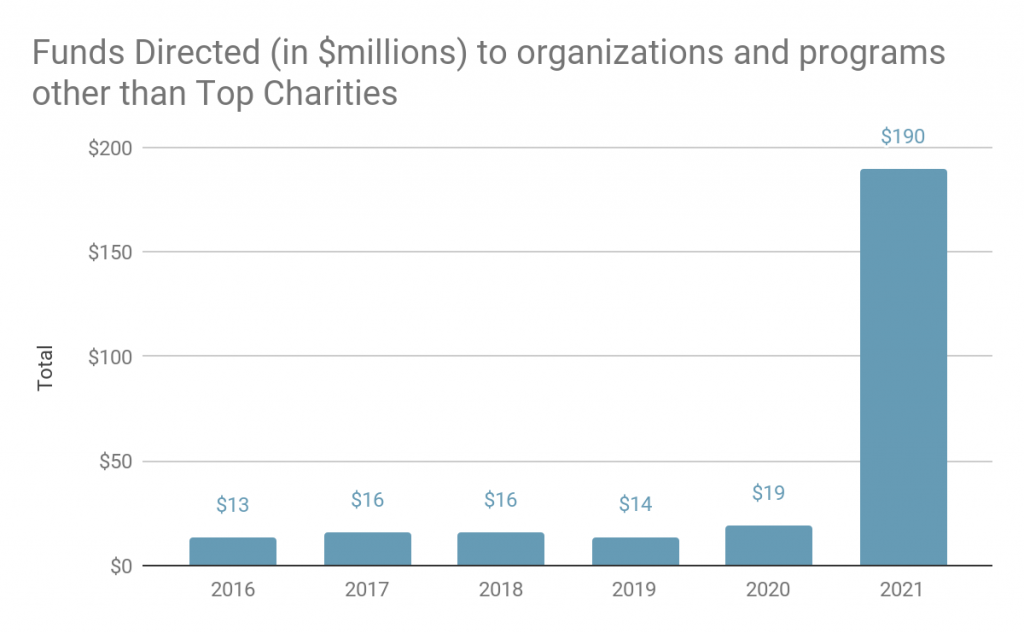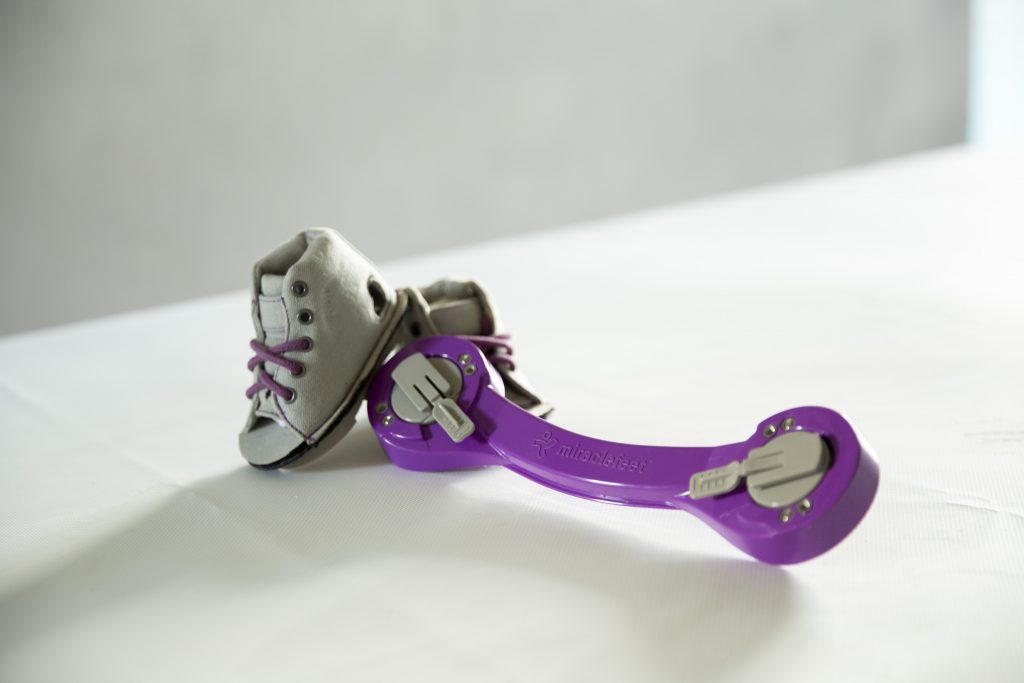For many people, GiveWell is practically synonymous with our short list of top charities. But the amount of money we’ve sent to other organizations, doing other important work, has been increasing. In 2021, we made or recommended about $190 million in grants to non–top charity programs, like water treatment and malnutrition treatment, and in 2022, we set up the All Grants Fund specifically so donors could contribute to programs in this category.

Source: GiveWell, GiveWell Metrics Report — 2021 Annual Review, p. 9
We want to use this blog to give you more frequent, brief insights into these newer areas of our grantmaking before we publish our formal grant write-ups. Below we’ll discuss, in light detail, a program that’s well outside of our traditional wheelhouse, but that we think significantly improves children’s lives—treatment for clubfoot with an organization called MiracleFeet.
The grant
Clubfoot is a congenital (i.e., present from birth) abnormality that causes one or both feet to twist inward and upward. Children born with clubfoot must walk on the sides or backs of their feet, which leads to pain, severely limited mobility, and, reportedly, social stigma. If not corrected, clubfoot is a lifelong condition.[1] In January 2023, we recommended a $5.2 million grant to MiracleFeet to expand its existing clubfoot treatment program in the Philippines and launch two new programs in Chad and Côte d’Ivoire.[2]
In the countries where it works, MiracleFeet and its local NGO partners help health facilities diagnose and treat clubfoot, using a process called the Ponseti method. This generally requires placing the affected foot in a series of casts, performing a minor surgical procedure to improve the foot’s flexibility, and bracing the foot during sleep for up to five years.[3] MiracleFeet and its partners provide supplies for casting and bracing, train government health care workers in the above procedures, build awareness of clubfoot, and help health systems collect data on treatment.[4] This makes it comparable to a “technical assistance” program: MiracleFeet doesn’t perform clubfoot treatment itself; instead, along with its partners, it helps set health facilities up to successfully find and treat clubfoot cases themselves.

The brace and custom shoes supplied by MiracleFeet for clubfoot treatment. Photograph courtesy of MiracleFeet.
We were excited to recommend this grant because we think it will probably result in a lot more kids being treated for a serious, lifelong condition that nevertheless appears neglected. Clubfoot is debilitating but not life-threatening, and affects only about 1 in 800 babies born.[5] In resource-strapped countries, a relatively new and involved treatment like the Ponseti method may not be prioritized unless an NGO like MiracleFeet is there to advocate for and assist with it.[6] We estimate that MiracleFeet will support treatment of about 10,000 children with this grant, and that only about 10% of those children would get treated absent MiracleFeet,[7] though we don’t feel very certain about this (more below).
All in all, after adjustments, we think that this grant will lead to about 3,700 cases of clubfoot successfully treated that otherwise wouldn’t have been, and that will result in lifelong mobility gains and pain relief for the children treated.[8]
Why this grant is different
MiracleFeet’s program is different from our top charities for a few reasons:[9]
- The program is expensive compared with our top charities. The Ponseti method requires specialized equipment, training for medical staff, and a multi-step execution with years of subsequent follow-up. In the countries funded by this grant, we estimate that MiracleFeet’s program costs a little over $500 per treatment, compared with (for example) about $1 per child given vitamin A supplements through Helen Keller International.
- But it’s also much more targeted. Our current top charities increase coverage of blanket preventive measures—ones given to all children in the target age group, whether or not they would have eventually become sick. By contrast, all the children in MiracleFeet’s program have clubfoot and need an intervention to gain full mobility. The higher cost is offset by closer targeting of the kids who will benefit.
- The main benefit is reduced disability, not lives saved or income gained. While our top charities’ work primarily saves lives, MiracleFeet’s program focuses on reducing or avoiding disability—thus reducing pain and suffering, and indirectly increasing income (since improved mobility means more opportunity to work[10]). In our cost-effectiveness analysis for this grant, we used our moral weights to compare the value of saving lives to that of avoiding disability and raising incomes.
To do that, we also needed to answer the question of how bad clubfoot is. We have a generic value for a year of avoiding disability, but we needed to multiply it by another value that would represent the burden of clubfoot specifically.The source we typically rely on for measures of disease burden doesn’t provide a disability weight for clubfoot, so we had to find a proxy among the conditions it does list. We considered a couple of options that represented higher and lower degrees of severity, and spoke with a disability expert and reviewed related literature to get a better sense of clubfoot’s effects. In the end, we settled on a value that seemed to match clubfoot’s combination of pain, impairment, and stigma.[11] This was ultimately a judgment call based on what we had learned about clubfoot over time.
What we’re still learning
Our preliminary cost-effectiveness estimate put MiracleFeet’s program close to meeting our bar for funding. Still, we had a lot of uncertainty about the ultimate impact of this grant, including the counterfactual impact of the program—that is, how many more kids would be treated for clubfoot because of MiracleFeet’s work in these countries? Because MiracleFeet provides assistance for treatment, but not the treatment itself, it’s tougher to draw a straight line from its work to impact. We were also unsure about existing access to treatment in the three countries where MiracleFeet would be working; we had been told that treatment is scarce in the Philippines, and essentially nonexistent in Chad and Côte d’Ivoire, but we didn’t have independent confirmation of that.
We saw a grant to MiracleFeet as a learning opportunity, in addition to the direct benefit it would have on children’s lives. MiracleFeet and its partners already collect some data on the program,[12] but if we could fund additional information-gathering on the number of children treated before program launch (or expansion, in the case of the Philippines), then measure the same numbers a few years later, we’d have a clearer idea of what a program like this accomplishes with philanthropic support. We could use that information to make better decisions not only about whether to fund MiracleFeet again in the future, but also about whether to fund other clubfoot treatment programs.
When we factored in what we’d get out of a separate grant for monitoring and evaluation—what we call “value of information”—the whole opportunity looked cost-effective. In May 2023, we recommended a separate grant of about $600,000 for an external evaluator in each of the three countries to conduct those before-and-after surveys of clubfoot treatment levels, which we hope will give us the extra data we’re looking for.[13]
It’s possible, of course, that these monitoring activities will tell us that the program doesn’t have much of an effect—meaning we might look back several years from now and decide that we wouldn’t have made the initial grant, given what we learned. It’s a risk inherent in all the work GiveWell does, and, we think, a greater risk for newer-to-us programs like this one. But the upside of a positive finding is considerable! Even learning that the program isn’t very effective would be valuable, since it would allow us to more confidently steer our funding toward more cost-effective uses.
There’s a lot we don’t know about clubfoot treatment, and a lot we hope to learn in the coming years. We’re grateful for the more flexible funding we get from our donors so we can continue to invest in our learning and expand our funding’s reach beyond top charities.

Comments
I’m truly thrilled to see GiveWell highly evaluating charities that emphasize the alleviation of pain and suffering rather than simply saving lives. May I humbly suggest StrongMinds, which effectively treats depression in Uganda and Zambia, for your consideration? Thank you so much!
Hi, Brian!
Thanks for your comment. We replied to a similar comment here. In short: we evaluated the Happier Lives Institute’s cost-effectiveness analysis of StrongMinds here and estimate that it is about 25% as cost-effective as the marginal dollar to our top charities. However, our analysis is based on several uncertain considerations, and our estimate might change with more research. We may do more work to evaluate StrongMinds in the future, including reviewing results of an upcoming randomized controlled trial of the program in Uganda and another, unpublished trial conducted by StrongMinds.
Best,
Miranda
Hello,
Have you done any similar analysis of psychedelic-assisted therapy?
Matt
Hi Matt,
We haven’t prioritized investigating MDMA-assisted therapy for PTSD and psilocybin-assisted therapy for depression because these interventions seem unlikely to be within the range of cost-effectiveness of interventions we would consider directing funding to at this time.
Please feel free to visit our list of prioritized programs to see the types of interventions we are currently investigating.
Best,
Roman
This was very insightful, thanks for sharing! At Childrens HeartLink, we provide pediatric cardiac centers in developing countries with technical assistance and capacity building, so they can serve more children with heart disease, and treat more complex heart disease. I’ll be curious to learn more as you identify counterfactual impact, as that’s something we’re always exploring as well.
Hi,
When friends ask me about Givewell, they try and vet the organization via BBB Charity Review and find that there is no rating . A deeper look shows that Givewell will not submit to their request for information. “The BBB encourages charities to disclose accountability information beyond that typically included in financial statements and government filings, in order to demonstrate transparency and strengthen public trust in the charitable sector.”
While I have no connection to the BBB, it seems that many of us have used this organization over our lifetime to weed out bad players in business. It just seems odd that Givewell is avoiding the effort that other charities provide to allow a rating by the BBB. My friends seem suspicious. I dont know what to tell them. Can you shed light on your decision to avoid what should be a positive endorsement from this organization? Thanks
Hi Jon,
Thanks for getting in touch regarding your concerns.
As a nonprofit, GiveWell has to make careful decisions on how to allocate its budget and resources. As our registration status with the Better Business Bureau has not been a major concern for most donors, we have not prioritized becoming rated due to the administration work and fees involved that would have to be diverted from other projects.
GiveWell is registered on CharityNavigator.com, an independent nonprofit evaluator. Currently, we hold a 4-star rating and a 93% based on their evaluations.
That said, it is on our radar to reevaluate our registration with the BBB and consider becoming rated in the future. Thank you for your support and feedback, and please let me know if you have any questions.
Best,
Miranda
Comments are closed.